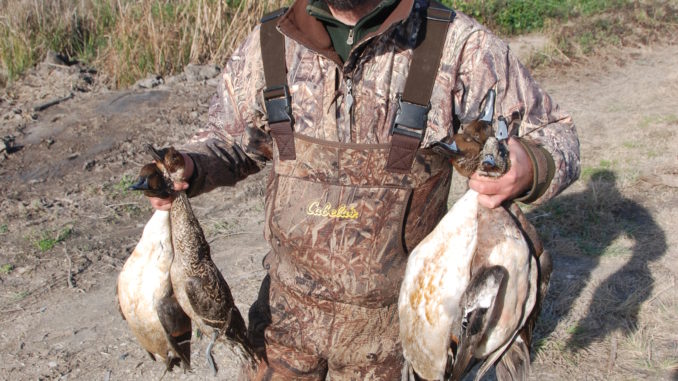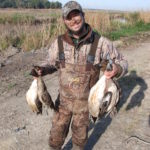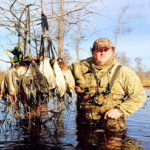
When ducks become wary, South Carolina hunters should considered doing something new
When South Carolina duck hunters take to the water for the short opening segment of the season around Thanksgiving, if the ducks are around, the hunting is relatively easy.
Fasts forward, however, to the second part of the season, which opens in early December and runs through Jan. 25. At some point, the “easy” ducks disappear, not that duck hunting itself is all that easy. Even first-year birds, born on the prairies in Canada, learn that any landing in a swamp, coastal river, or marsh could be their last, and they either get smart or die.
When ducks get smart, duck hunting takes on a whole new meaning.
Dean Harrigal, the waterfowl coordinator for the S.C. Department of Natural Resources, understands waterfowl as well or better than anyone in South Carolina, spending countless hours of preseason planning for the arrival of ducks during the season. He said one thing most hunters don’t understand is that the state doesn’t get a great number of migratory ducks the way so many “flyway” states do.
“We don’t get the new-bird thing as often as people want to believe,” Harrigal said. “We’re in the mid-latitudes of our flyway, and we get these rolling flights of birds. We get a big slug of birds coming in with the first cold front, and then, we’re just pushing them across the area until we get the really cold snaps in mid-January. We may kick up a few new birds, but it’s not like you read about in the magazines where you get influx of new birds with every front.”
Harrigal said the idea of a flyway where birds push due south is a misnomer. Weather patterns to our west affect duck migrations just as significantly. In fact, the species of duck and where it originates is a key element in knowing how it migrates.
“The rule of thumb that we talk about is, the further south we are in the flyway, the further west your birds come from,” he said. “In the Atlantic flyway, we get mallards and wood ducks and some green-winged teal to some extent from New England. But we also get more mallards and wood ducks and blue wings and ringers from the Great Lakes region. Then, we also get gadwall and green-winged teal and shovelers and blue-winged teal. Those are traditional prairie-nesting birds. Where we are in the flyway, we get birds from all sources.”
Regardless of what species it is or where it came from, by the time a duck gets to South Carolina, it has been shot at along every leg of its journey. Come January, if a duck hunter is still using the same tactics in the same locations he did in November, he’s not killing very many ducks.
Hunters like Robert Garmany of Charleston understand that. Between Thanksgiving and the end of January, when he’s not working at Haddrell’s Point Tackle in West Ashley, he’s either hunting ducks, scouting ducks and planning his next hunt. Garmany is a public-land hunter, preferring the area between Charleston and Beaufort, specifically the areas in the ACE Basin.
By January, he’s also factoring in that hard-hunted birds are going to require him to employ different tactics than those that worked earlier in the season.
Regardless of the blind you use, hard-hunted waterfowl have learned to avoid them. The stereotypical boxy structure — be it attached to land or a boat — has been used to kill ducks all season. But the same way that deer learn to avoid tree stands, ducks avoid blinds. The solution? Don’t use one.
“If I can get out of the boat and away from any kind of structural blind, I get away from it and hide the boat,” said Garmany. “A nice one-man pop-up blind doesn’t hurt you if you blend it in. Take some other material with you to help blend the blind in, especially in the marsh. Taking an extra five minutes will go a long way to help your duck-hunting success.
The next obvious way that ducks avoid being killed in the marsh is by sound. Some hunters liken the trait to combat warriors maneuvering in the jungle. Radio silence is a priority. Live ducks will use short and to-the-point vocalization among themselves. So should you, if at all.
“I will restrict myself from calling as much as possible, trying to listen to what the ducks are doing and trying to mimic what I’m hearing,” said Garmany. “Another thing to consider is that 90-percent of the duck calls on the market are mallard calls. We get very few mallards along the coast and usually only very late in the year. Teal, gadwalls and ring-necks have all heard mallard calls that resulted in being shot at, and they avoid them for the most part.”
January weather is ever changing. To a duck hunter, that’s a good thing, because cold fronts will push new birds into an area. New birds aren’t necessarily stupid, but a hunter may have a slightly better chance at fooling them because the hunter knows the terrain better than the bird.
“During the late season, I try to hunt the weather a lot more,” he said. “I really try to watch fronts come up. I mean, a lot of those days are overcast and rainy, but the main reason is a lot of our ducks are specialists on the coast is because they’re usually not going to sit in the ocean if it’s real choppy. It it gives the hunter a better chance to kill ducks because the ducks are going to come in into the feeder creeks to rest in the afternoons and mornings.”
Garmany spends a lot of time scouting between hunts, getting to know the areas they prefer to use, then using that knowledge to insert himself into the area where the ducks want to be.
“I’d say scouting is 80 to 90 percent of what I do when I’m on the water during duck season,” he said. “If there are no ducks in the area or you’re not seeing ducks in the area, why waste time sitting there all morning?
“Take a morning you’re off from hunting and kind of watch where ducks are going then try to figure out what’s going on with the duck population,” he said. “Afternoon scouting is also a great way to find out what areas the ducks are using. I use the afternoons, if I’m off work, to scout where ducks are coming from.
“Get with a good friend and let him go to one area and watch the area, and you go to another,” said Garmany. “By scouting, I mean sitting off of a rice field or sitting off in an area and watching birds through binoculars and seeing where ducks are going. However, do not disturb the birds, I truly believe if you run a duck out of an area, you’re going to make that duck leave that area.
As the season progress, several factors come into play that requires Garmany to change his decoy set-ups. The first is hunting pressure. Ducks tend not to gang up in bigger flocks but come and go in twos and threes, and they’re spooky, so less is better and motion, of the right kind, is more effective. Another thing is that the later it gets, the closer it gets to mating season when ducks are naturally going to pair off.
“Later in the season, I start putting my spinning-wing decoys away,” he said. “I will use them on certain days, but with a remote. If I notice it’s starting to flare birds, I can always turn it off. I’ve also gone to a pumper-style decoy, which I’ve found to be very successful. It’s just given the decoys more life, especially on calm, still mornings when there is no wind. It actually makes ripples in the water and keeps more life in your decoys. Another thing people really overlook is the effectiveness of a jerk string.
“On the other end of it, my decoy spread changes greatly by season end,” he said. “I’ll try match what I’m seeing. I don’t hunt with a bunch of mallard decoys during the late season (when) we have more green-wing teal, gadwalls, and ring-necks around. Also, I will watch ducks as they start pairing off, so instead of putting my decoys in groups, it’s more loose pairs.”







Be the first to comment